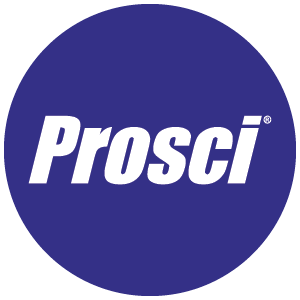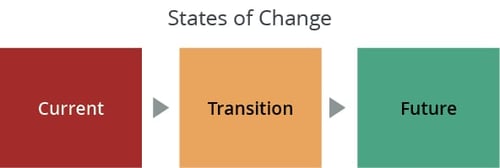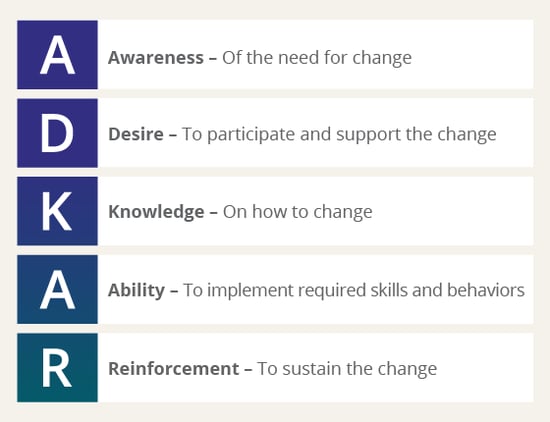Defining Change Competency

4 Mins
Updated: August 27, 2025
Published: November 9, 2022

What does an organization look like when it has developed change competency? It often starts with an organization facing constant demands to change and using effective change management over and over with each new initiative, which leads to a fundamental shift in operations. Sponsors repeat the activities that made the last change successful. People managers develop skills to support employees through the change. People on the front lines of the organization see navigating change as part of their job and the way the organization does business. Eventually, each role in the organization will have internalized their role in change and developed the knowledge and skills needed to react to it effectively. This change-ready organization has developed change competency.
What Is Change Competency?
Building change competency in an organization is not like installing a new computer system or implementing a new policy. Change competency requires a new attitude and approach. Individuals in a change-competent organization define their job in relation to change. They value the ability to change as one of their primary responsibilities. They understand that change will occur, expect it, and effortlessly perform during and after the change.
Change competency is the presence of a culture that expects change and reacts with the understanding, perspectives, tools and techniques to make change seamless and effortless. It is making change a part of “business as usual.”
How Does Change Competency
Differ From Change Management?
Change competency is similar to change management, with key distinctions.
First, change competency is not an activity. Prosci defines change management as the application of a structured process and set of tools for leading the people side of change to achieve a desired outcome. Change competency is an organization’s ability to react to and manage change over and over again. It's an enterprise-wide capability to apply change management practices successfully and routinely.
Second, while change management can be taught and learned, change competency requires a fundamental shift in culture and values. It must become part of day-to-day operations and cannot be simply demonstrated in training or instructional materials.
Finally, change competency must penetrate every level and facet of the organization, from the executive leadership to people on the front lines. An organization may have change management expertise in sponsors, consultants, and change management practitioners. However, the people who must work with the changes every day are the focus of much of the change management activities. In change-competent organizations, these people are key players. To build change competency, and organization must give individual people impacted by change the perspectives, tools and techniques they need to move through their transitions quickly and successfully.
The importance of impacted people during change
Impacted people on the front lines of the organization are especially important yet often neglected during change management efforts. Training and resources are readily available for sponsors, project teams, and even people managers, but stakeholders on front lines of an organization can get left behind.
Ironically, managing resistant behaviors is often identified as a top obstacle for change management teams in our Best Practices in Change Management research. And a separate study with business improvement teams shows that resistance by impacted people is the top inhibitor of project success. The lesson to be learned is that you must not underestimate the importance of impacted people and groups when managing change.

How a single change effects organizational roles
In change management, we prepare and equip core roles to fulfill specific responsibilities during each change, and we can work on more than one change at a time. Members of a project team may quickly move on to other projects or opportunities within the organization. And a sponsor often has many initiatives to support—this project is only a small part of the big picture.
However, people on the front lines may experience dramatic and ongoing changes to their daily work and professional life as a result of one change. It may introduce systems, processes or approaches that are new and intimidating. The change may even do away with everything the person knows or feels comfortable doing in their daily work. Building change competency in an organization requires preparing, equipping and supporting people on the front lines, so they truly understand how to make their transition and succeed in a constantly changing world.

Evidence of Change-Competence
In change-competent organizations, people in key roles exhibit certain behaviors and attributes:
Executives – constantly search for ways to improve profitability and growth by reacting to marketplace changes and opportunities, and ensure that business changes are implemented and realized to their full potential through effective leadership and fulfilling the ABCs of change sponsorship.
Project teams – can support sponsors, managers and front-line employees through the change process with skills, processes and tools to manage change.
People managers – can prepare, equip and support people through the individual change process, provide direction and training for professional development, and encourage successful performance during the transition and in the new environment.
Front-line employees – can perform successfully in the current environment, during the transition, and in the future state. They have the tools and processes to effectively manage their personal transition through change.

Use ADKAR to Build
a Change-Competent Culture
When you build change competency, you must equip all levels of your organization with the understanding, perspectives, tools and techniques to make change seamless and effortless. You can use the ADKAR Model to assess where your organization stands today and develop an action plan to move toward change competency.

Consider the following statements as they relate to your organization:
- The organization understands the importance of responding quickly and efficiently to internal and external pressures to change.
- The organization understands what change competency is and the associated risks of not developing change competency.
- All groups understand the business reasons and drivers for making this change in culture, values and skills for managing change.
- The organization recognizes the impact on its livelihood and operations if change competency is not developed and is motivated to create organizational change competency.
- All groups acknowledge that the ability to change is critical if the organization is to thrive, and they are ready and willing to begin the journey toward becoming a change-competent organization.
- The organization has the base knowledge of what a change-capable organization looks like, and what skills and values are required.
- All areas of the organization have a basic understanding of change management theories and practices, and can apply a change management process to business projects.
- Each group understands its role in a change-competent organization.
- The organization possesses and effectively utilizes the tools and processes to manage change.
- Leaders, change practitioners, and people on the organization's front lines have practice and coaching in being successful change agents, and can routinely apply their knowledge and skills to realize change.
- The organization encourages and rewards successful change through its culture, values and initiatives.
- Support of change competency is reinforced and resistance to change is identified and managed.
- Change is part of “business as usual.”
Start Building Change Competency
Change is a process, and becoming a change-competent organization takes time. And because building change competency is a change itself for the organization, it must be managed as a project and a change. This starts by recognizing where you are today in terms of change competency, where you want to be in the future, and what it will take to to get you there.



